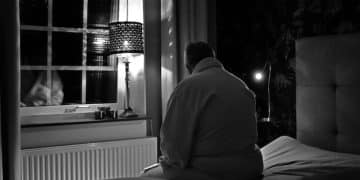The Updated Guide to Managing Male Postpartum Depression in the US

The Updated Guide to Managing Male Postpartum Depression: Symptoms, Support, and Treatment Options Available in the US addresses the often-overlooked mental health challenges faced by new fathers, providing essential information on symptoms, available support networks, and effective treatment strategies in the United States.
Becoming a parent is a life-altering experience filled with joy, but also challenges. While postpartum depression (PPD) is commonly associated with mothers, it’s crucial to recognize that men can experience it too. The Updated Guide to Managing Male Postpartum Depression: Symptoms, Support, and Treatment Options Available in the US aims to shed light on this often-overlooked condition, providing resources and guidance for fathers and their families.
This guide will explore the symptoms of male PPD, understand the contributing factors, and outline the various support and treatment options available across the United States. Recognizing that men experience postpartum depression differently, it is essential to understand and address the nuances they face.
Understanding Male Postpartum Depression: An Overview
Male postpartum depression is a significant yet often undiagnosed issue that impacts new fathers. It’s essential to recognize that the transition to parenthood can bring about emotional and psychological changes for men as well, influencing their mental health. In this section, we delve into what male PPD is, its prevalence, and why it’s vital to address it with understanding and care to help inform The Updated Guide to Managing Male Postpartum Depression: Symptoms, Support, and Treatment Options Available in the US.
What is Male Postpartum Depression?
Male postpartum depression, also known as paternal postpartum depression, is a mental health condition that affects men after the birth of a child. It involves feelings of sadness, anxiety, irritability, and fatigue that can significantly impact a new father’s ability to bond with their baby and support their partner. Though less discussed than maternal PPD, it is a real and significant concern.
Prevalence of Male PPD
Studies suggest that between 4% and 25% of new fathers experience postpartum depression. The prevalence can be higher in fathers who have a history of depression, relationship problems, financial stress, or whose partners are also experiencing postpartum depression. Understanding these statistics highlights the need for greater awareness and screening for paternal PPD.
Why Addressing Male PPD Matters
Addressing male PPD is crucial for several reasons. First, a father’s mental health directly impacts their ability to care for and bond with their child. Secondly, paternal depression can affect the mother’s mental health and the overall family dynamic. Early identification and treatment improve outcomes for both parents and children, fostering a healthier and more supportive family environment.

In summary, recognizing and addressing male postpartum depression is essential for the well-being of fathers, mothers, and children. It requires understanding the condition, acknowledging its prevalence, and providing the necessary support and treatment to ensure healthier family outcomes. The Updated Guide to Managing Male Postpartum Depression: Symptoms, Support, and Treatment Options Available in the US aims to provide this information.
Recognizing the Symptoms of Male Postpartum Depression
Identifying the symptoms of male postpartum depression can be challenging because they often differ from those experienced by mothers. Understanding these signs is the first step in seeking help and ensuring that new fathers receive the support they need. This segment offers a detailed look into the symptoms associated with male PPD, aiding early recognition and intervention for The Updated Guide to Managing Male Postpartum Depression: Symptoms, Support, and Treatment Options Available in the US.
Common Symptoms of Male PPD
Symptoms of male PPD can vary, but some common indicators include:
- Irritability and Anger: Increased frustration and a short temper.
- Loss of Interest: A decline in interest in hobbies, sex, or social activities.
- Fatigue: Persistent tiredness and lack of energy.
- Changes in Sleep and Appetite: Difficulty sleeping or oversleeping, and changes in eating habits.
- Anxiety and Worry: Excessive worrying, often about finances or the baby’s well-being.
Emotional and Psychological Symptoms
In addition to the common symptoms, men may also experience:
- Sadness and Hopelessness: Feelings of sadness, emptiness, or hopelessness.
- Feeling Overwhelmed: A sense of being unable to cope with the responsibilities of fatherhood.
- Withdrawal: Social isolation and pulling away from family and friends.
- Thoughts of Self-Harm: In severe cases, thoughts of harming oneself or the baby.
Physical Symptoms
Physical symptoms are less commonly discussed but can include:
- Headaches: Frequent or severe headaches.
- Digestive Problems: Stomach issues, such as nausea or changes in bowel habits.
- Muscle Tension: Increased muscle tension and aches.
- Changes in Libido: Decreased sexual desire or performance.
In short, being aware of the variety of symptoms linked to male postpartum depression is crucial so that men can seek timely support and treatment, improving mental health results and fostering healthier bonds with their families. The Updated Guide to Managing Male Postpartum Depression: Symptoms, Support, and Treatment Options Available in the US serves to enhance this awareness and preparedness.
Factors Contributing to Male Postpartum Depression
Several factors can contribute to male postpartum depression, ranging from hormonal changes to social and environmental stressors. Understanding these factors is essential for identifying at-risk individuals and implementing preventive strategies. This section explores the key elements that can increase a man’s likelihood of experiencing PPD, providing a comprehensive overview for The Updated Guide to Managing Male Postpartum Depression: Symptoms, Support, and Treatment Options Available in the US.
Hormonal Changes in Men
Though less pronounced than in women, men also experience hormonal changes after the birth of a child. Testosterone levels can decrease, and levels of cortisol and prolactin may increase. These hormonal shifts can affect mood and contribute to feelings of depression and anxiety. Awareness of these hormonal factors is valuable.
Sleep Deprivation and Stress
The arrival of a new baby often leads to significant sleep deprivation and increased stress for both parents. These factors can exacerbate mental health issues, making men more vulnerable to postpartum depression. Lack of sleep affects mood, decision-making, and overall well-being, thereby contributing to depression.
Relationship and Financial Strain
The stress of a new baby can strain relationships, leading to increased conflict and decreased emotional support. Financial concerns related to the costs of raising a child can also contribute to anxiety and depression. Addressing these strains through counseling and financial planning can mitigate the risk of PPD.

Lack of Social Support
Men often receive less social support than women during the postpartum period. Isolation and a lack of emotional outlets can increase the risk of depression. Encouraging men to connect with other fathers and seek support from friends and family is crucial.
Recognizing these contributing factors helps in developing targeted methods to support new fathers and minimize their risk of developing postpartum depression. By knowing the potential causes and effects, The Updated Guide to Managing Male Postpartum Depression: Symptoms, Support, and Treatment Options Available in the US can supply greater relief and aid in preventing and reducing the likelihood of postpartum depression in men.
Support Options for Men Experiencing Postpartum Depression in the US
Navigating postpartum depression can be challenging, but numerous support options are available in the US to help men cope and recover. This section outlines various resources and support systems that provide assistance, encouragement, and professional guidance for fathers experiencing PPD. From therapy and medication to support groups and lifestyle changes, The Updated Guide to Managing Male Postpartum Depression: Symptoms, Support, and Treatment Options Available in the US offers a thorough assessment of options.
Therapy and Counseling
Therapy is a cornerstone of treatment for male postpartum depression. Cognitive Behavioral Therapy (CBT) and Interpersonal Therapy (IPT) are two effective approaches. CBT helps men identify and change negative thought patterns, while IPT focuses on improving relationships and social interactions. Professional counseling provides a safe space to express feelings and develop coping strategies.
Medication
In some cases, medication may be necessary to manage the symptoms of postpartum depression. Antidepressants, such as selective serotonin reuptake inhibitors (SSRIs), can help regulate mood and alleviate symptoms. It’s essential to consult with a healthcare provider to determine the most appropriate medication and dosage.
Support Groups and Online Communities
Joining a support group or online community can provide a sense of connection and reduce feelings of isolation. Sharing experiences with other fathers who are also struggling with PPD can be incredibly validating and empowering. These groups offer a platform for sharing coping strategies and receiving emotional support.
- Postpartum Support International (PSI): Offers online and local support groups for new parents.
- The Fatherhood Project: Provides resources and support for fathers, including those experiencing PPD.
- Online Forums: Platforms like Reddit and Facebook have groups where fathers can connect and share their experiences.
Lifestyle Changes
Adopting healthy lifestyle habits can also play a significant role in managing postpartum depression:
- Regular Exercise: Physical activity releases endorphins, which can improve mood and reduce stress.
- Healthy Diet: Eating a balanced diet can provide essential nutrients and support overall well-being.
- Adequate Sleep: Prioritizing sleep, even in short intervals, can help reduce fatigue and improve mood.
- Mindfulness and Relaxation Techniques: Practicing mindfulness, meditation, or deep breathing exercises can help manage anxiety and stress.
To sum it up, numerous support choices are available in the United States to support men in overcoming postpartum depression. Treatment plans can be tailored to suit specific requirements and circumstances by integrating therapy, drugs, support groups, and lifestyle modifications, thus enhancing results for men and their families. The Updated Guide to Managing Male Postpartum Depression: Symptoms, Support, and Treatment Options Available in the US highlights these extensive support mechanisms.
Treatment Options for Male Postpartum Depression
Effectively treating male postpartum depression requires a multifaceted approach that addresses both the psychological and physiological aspects of the condition. This section delves into the evidence-based treatment options available, including therapy, medication, and alternative therapies, providing a comprehensive overview for The Updated Guide to Managing Male Postpartum Depression: Symptoms, Support, and Treatment Options Available in the US.
Psychotherapy
Psychotherapy, or talk therapy, is a primary treatment option for male PPD. Cognitive Behavioral Therapy (CBT) helps men identify and change negative thinking patterns and behaviors that contribute to depression. Interpersonal Therapy (IPT) focuses on improving communication and resolving relationship issues that may be contributing to the condition. Therapy is a helpful tool.
Medication Management
Antidepressant medications, such as selective serotonin reuptake inhibitors (SSRIs), may be prescribed to help regulate mood and alleviate symptoms of depression. It’s essential to work closely with a healthcare provider to determine the most appropriate medication, dosage, and duration of treatment. Medication requires correct management.
Alternative Therapies
In addition to traditional treatments, several alternative therapies may help manage the symptoms of male PPD:
- Acupuncture: Some studies suggest that acupuncture can help reduce symptoms of depression and anxiety.
- Mindfulness Meditation: Practicing mindfulness meditation can help men become more aware of their thoughts and feelings, reducing stress and improving mood.
- Yoga: Yoga combines physical exercise with mindfulness and relaxation techniques, which can help reduce stress and improve overall well-being.
The Role of Family and Couples Therapy
Postpartum depression can affect the entire family, making family and couples therapy a valuable component of treatment. These therapies can help improve communication, strengthen relationships, and address underlying issues that may be contributing to the man’s depression. The family dynamic is important.
- Improving communication between partners.
- Strengthening the emotional bond between parents.
- Addressing any unresolved conflicts or issues.
In conclusion, a variety of treatment choices work well for treating male postpartum depression, ranging from standard psychotherapy and medicine management to alternative and family-focused treatments. Tailoring treatment strategies to meet the specific needs and circumstances of each male can lead to better results and enhanced family well-being, as described in detail throughout The Updated Guide to Managing Male Postpartum Depression: Symptoms, Support, and Treatment Options Available in the US.
| Key Point | Brief Description |
|---|---|
| 💡 Symptoms | Recognize irritability, fatigue, and loss of interest. |
| 🤝 Support | Join support groups and seek therapy. |
| 💊 Treatment | Consider medication and lifestyle changes. |
| 🌱 Self-Care | Prioritize sleep, diet, and exercise. |
Frequently Asked Questions (FAQ)
Symptoms include irritability, fatigue, loss of interest, changes in sleep and appetite, anxiety, and feelings of being overwhelmed. Recognizing these signs is crucial for The Updated Guide to Managing Male Postpartum Depression: Symptoms, Support, and Treatment Options Available in the US.
Studies suggest that between 4% and 25% of new fathers experience postpartum depression. The prevalence can be higher in fathers with a history of depression or relationship problems.
Treatment options include therapy, medication, support groups, and lifestyle changes such as regular exercise, a healthy diet, and prioritizing sleep. The Updated Guide to Managing Male Postpartum Depression: Symptoms, Support, and Treatment Options Available in the US covers these options in detail.
Encourage them to seek professional help, offer emotional support, help with childcare responsibilities, and ensure they have time for self-care. Open communication is key to addressing these challenges.
Organizations like Postpartum Support International and The Fatherhood Project offer resources and support for fathers experiencing PPD. Always consult with healthcare professionals for personalized advice as highlighted with our The Updated Guide to Managing Male Postpartum Depression: Symptoms, Support, and Treatment Options Available in the US.
Conclusion
In conclusion, understanding and addressing male postpartum depression is critical for the well-being of fathers, mothers, and children in the United States. By recognizing the symptoms, understanding the contributing factors, and utilizing the available support and treatment options, we can improve outcomes for families affected by this often-overlooked condition.
The Updated Guide to Managing Male Postpartum Depression: Symptoms, Support, and Treatment Options Available in the US has shed light on the issue of paternal PPD. By fostering open conversations and providing access to resources, we can help new fathers navigate the challenges of parenthood and build stronger, healthier families.





